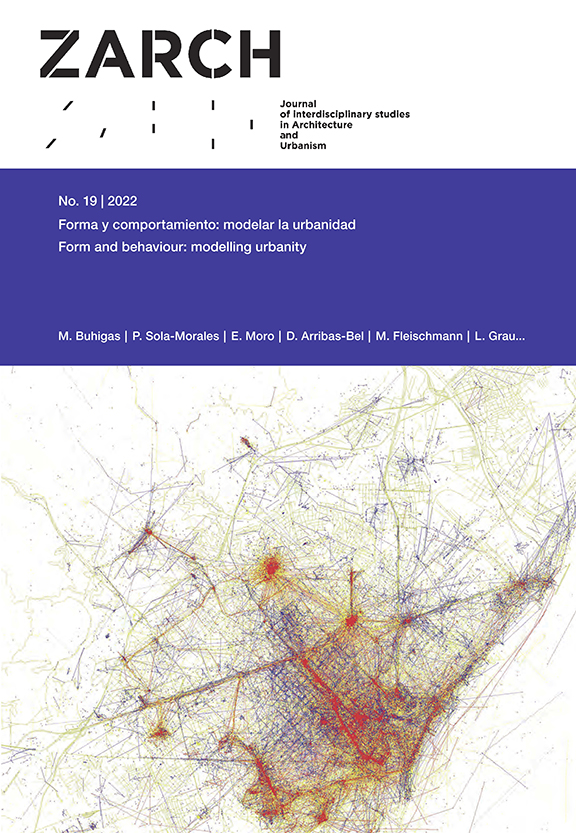Modelo de Información Urbana de Barrio (MIUB) para regeneración urbana: una propuesta metodológica
DOI:
https://doi.org/10.26754/ojs_zarch/zarch.2022196924Palabras clave:
regeneración urbana, métodos basados en datos, métodos de evaluación, Sistemas de Información Geográfica, Building Information ModellingResumen
La regeneración urbana es un campo en el que los métodos basados en datos han demostrado su utilidad tanto para el análisis de necesidades como para la simulación de actuaciones. Tras sintetizar el panorama actual en España a este respecto, este artículo presenta los planteamientos metodológicos de sucesivos trabajos desarrollados en esta materia en la Comunidad Autónoma de Castilla y León, así como los fundamentos de un método denominado “Modelo de Información Urbana de Barrio” (MIUB) orientado a la evaluación previa de actuaciones de regeneración urbana, y que parte del uso de datos abiertos y de su tratamiento mediante procedimientos sencillos a través de software de uso habitual del ámbito de los Sistemas de Información Geográfica y el Building Information Modelling. Aunque estas premisas imponen las limitaciones actualmente inherentes a los métodos que renuncian a procesos complejos de tratamiento de datos y a la generación de herramientas tecnológicas o informáticas ad hoc, se constata su utilidad para caracterizar las necesidades de regeneración de los tejidos urbanos y evaluar desde una lógica comparativa posibles actuaciones de intervención en ámbitos definidos en ellos.
Mostras las descargas
Referencias
Arcas-Abella, Joaquim; Pagès-Ramon, Anna; Bilbao, Ander. 2021. Herramienta urbanZEB. Hacia el desarrollo de estrategias urbanas de transición energética de edificios. ACE Architecture, City and Environment 16-46: 9888. http://dx.doi.org/10.5821/ace.16.46.9888
Costa, Francisco P.; Santos Silva, Carlos A. 2021. Urban Modeling and Analytics in a Smart Context. En Towards Energy Smart Homes: Algorithms, Technologies, and Applications, eds. Stephane Ploix, Manar Amayri y Nizar Bouguila, 1-19. Cham: Springer Nature. https://doi.org/10.1007/978-3-030-76477-7
De las Rivas Sanz, Juan Luis, dir. 2011. PRICYL Plan de Rehabilitación Integral de Castilla y León. Valladolid: Instituto Universitario de Urbanística de la Universidad de Valladolid. http://www.jcyl.es/junta/cf/20120209_PRICyL.pdf
De las Rivas Sanz, Juan Luis, dir. 2015. ERUCyL Estrategia de Regeneración Urbana de Castilla y León. Valladolid: Instituto Universitario de Urbanística de la Universidad de Valladolid. https://www.jcyl.es/junta/cma/ERUCyL.pdf
De las Rivas Sanz, Juan Luis, dir. 2018. Diseño y propuesta de una herramienta de desarrollo I+D+i de la Estrategia de Regeneración Urbana de Castilla y León. Valladolid: Instituto Universitario de Urbanística de la Universidad de Valladolid (inédito).
De las Rivas Sanz, Juan Luis; Fernández-Maroto, Miguel; Rodrigo González, Enrique; Martínez Sierra, Mónica. 2017. Recuperando el concepto urbanístico de barrio: unidades urbanas y regeneración urbana en Castilla y León. Ciudad y Territorio Estudios Territoriales 49-191 (primavera): 45-62. https://recyt.fecyt.es/index.php/CyTET/article/view/85828
De Santiago Rodríguez, Eduardo. 2018. Herramientas de diagnóstico para las intervenciones de regeneración urbana integrada en la ciudad consolidada: ejemplos de España. Limaq 4: 219-46. https://doi.org/10.26439/limaq2018.n004.2658
Fernández-Maroto, Miguel; Rodrigo González, Enrique. 2018. La Estrategia de Regeneración Urbana en Castilla y León (ERUCyL). Ciudad y Territorio Estudios Territoriales 50-196 (verano): 375-83. https://recyt.fecyt.es/index.php/CyTET/article/view/76668
García-Araque, Jesús; García-Cuesta, José Luis. 2020. Propuesta y ensayo de una metodología de identificación de la vulnerabilidad urbana. Ciudad y Territorio Estudios Territoriales 52-205 (otoño): 455-76. https://doi.org/10.37230/CyTET.2020.205.02
Martín-Consuegra, Fernando; de Frutos, Fernando; Hernández-Aja, Agustín; Oteiza, Ignacio; Alonso, Carmen; Frutos, Borja. 2022. Utilización de datos catastrales para la planificación de la rehabilitación energética a escala urbana: aplicación a un barrio ineficiente y vulnerable de Madrid. Ciudad y Territorio Estudios Territoriales 54-211 (primavera): 115-36. https://doi.org/10.37230/CyTET.2022.211.7
Martín-Consuegra, Fernando; Hernández-Aja, Agustín; Oteiza, Ignacio; Alonso, Carmen. 2019. Distribución de la pobreza energética en la ciudad de Madrid (España). EURE 45-135 (mayo): 133-52. http://dx.doi.org/10.4067/S0250-71612019000200133
Rodríguez-Suárez, Iván; Hernández-Aja, Agustín; Gómez-Giménez, José Manuel; Matesanz-Parellada, Ángela; Díez-Bermejo, Ana. 2021. Los Catálogos de Barrios Vulnerables de España: análisis de la vulnerabilidad en las ciudades españolas entre 1991 y 2011. Ciudad y Territorio Estudios Territoriales 53 (monográfico): 179-200. https://doi.org/10.37230/CyTET.2021.M21.10
Temes, Rafael R. 2014. Valoración de la vulnerabilidad integral en las áreas residenciales de Madrid. EURE 40-119 (enero): 119-49. http://dx.doi.org/10.4067/S0250-71612014000100006
Temes Córdovez, Rafael R. 2019. Visor de Espacios Urbanos Sensibles (VEUS). Una nueva herramienta para intervenir en la ciudad. En Actas del III congreso Internacional ISUF-H: Ciudad compacta vs. Ciudad difusa, 454-61. Valencia: Universitat Politècnica de València. http://dx.doi.org/10.4995/ISUFh2019.2019.9006
Tirado Herrero, Sergio. 2017. Energy poverty indicators: A critical review of methods. Indoor and Built Environment 26-7: 1018-31. https://doi.org/10.1177/1420326X17718054
URBANopt (Urban Renewable Building And Neighborhood optimization), https://docs.urbanopt.net/ (consultada el 8 de septiembre de 2022).
Zhu, Junxiang; Wright, Graeme; Wang, Jun; Wang, Xiangyu. 2018. A Critical Review of the Integration of Geographic Information System and Building Information Modelling at the Data Level. International Journal of Geoinformation 7-2: 1-16. https://doi.org/10.3390/ijgi7020066
Descargas
Publicado
Número
Sección
Cómo citar
Aceptado 2022-10-06
Publicado 2023-02-11







